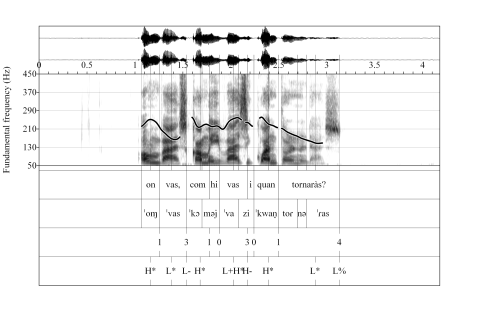Break indices of level 3 (BI 3) correspond to the end of minor prosodic units: they mark the boundaries of intermediate phrases, or ips.
In Catalan, there is a clear distinction between two degrees of perceived disjuncture. The end of the weaker disjuncture corresponds to a level 3 break index in the ToBI system, while the strong disjuncture corresponds to a level 4 break index. The main cues of level 4 are the following. Like the intonational phrase, the intermediate phrase is tonally and durationally marked after its final pitch accent, yet not as strongly as the intonational phrase. Typically, H- boundary tones, also called continuation rises, mark the end of an intermediate phrase.
For more information, see Prieto et al. (2015) and Vanrell & Prieto (2024).
Example
On vas, com hi vas i quan tornaràs?
[Where are you going, how are you getting there and when will you be back?]

In this example, there are six prosodic words assembled in three intermediate phrases.
The first ip on vas is constituted of two PrWords and ends with a L- boundary tone but it is not followed by a pause.
The second ip is com hi vas, constituted of the two PrWords com and hi vas, ends with an H- boundary tone -that is, a continuation rise- and it is not followed by a pause either. Notice that the last segment, which is a fricative, is voiced since it is between two vowels. This could not be the case if it were in IP-final position.
The third ip i quan tornaràs is also constituted of two PrWords and ends with a L% boundary tone, which is followed by a pause.
Thus, in this example, there are three boundary tones but only the third one is followed by a pause. That means that this sentence contains one IP, made of three ips. The first two boundary tones that are not followed by a pause correspond to BI 3.
- To see how to discriminate between BI 3 and BI 4: click here
